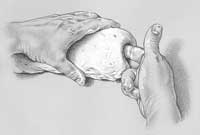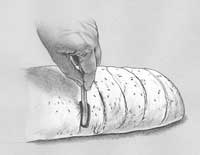Rye Bread
In search of a rye bread recipe that was moist and chewy but not too dense, with a notably tangy rye flavor, we found the sponge method of preparing dough to be superior on several counts. Fermentation made for more flavor and a somewhat more loose and less even texture (these being good things), and the bread made from a sponge also maintained more of its moisture during storage. While it's not easy to find more than one type of rye flour in the grocery store, after testing several, we found King Arthur light rye and Pillsbury medium rye to be best. Because rye flour is low in gluten, it had to be combined with protein-rich wheat flour.
If you do not have a heavy-duty standing mixer with at least a 4-quart capacity, the recipe can be halved. The rye flakes add flavor to the bread, but if unavailable, they can be omitted from the recipe.
Ingredients
Sponge:
| 2/3 | cup rye flakes (optional) |
| 2¾ | cups water |
| 1½ | teaspoons dry active yeast |
| 2 | tablespoons honey |
| 3 | cups unbleached all-purpose flour or bread flour |
Rye Bread:
| 1½ | cups unbleached all-purpose flour or bread flour |
| 3½ | cups rye flour, such as Pillsbury medium rye or King Arthur light rye |
| 2 | tablespoons caraway seeds |
| 2 | tablespoons vegetable oil |
| 1 | tablespoon table salt |
| Cornmeal for sprinkling |
Glaze:
| 1 | egg white |
| 1 | tablespoon milk |
Instructions
- For the sponge: Heat oven to 350 degrees; toast rye flakes on small baking sheet until fragrant and golden brown, about 10-12 minutes. Cool to room temperature. Mix water, yeast, honey, rye flakes, and flour in the large mixing bowl of a heavy-duty mixer to form a thick batter. Cover with plastic wrap, and let sit until bubbles form over entire surface, at least 2 1/2 hours. (Can stand at room temperature overnight.)
- For the bread: Stir all-purpose flour, 3 1/4 cups rye flour, caraway seeds, oil, and salt into the sponge. With machine fitted with dough hook and set on speed 2, knead dough, adding the remaining 1/4 cup rye flour once the dough becomes cohesive; knead until smooth yet sticky, about 5 minutes. With moistened hands, transfer dough to a well-floured counter, knead it into a smooth ball, then place in a lightly greased bowl. Cover with plastic wrap and let rise at warm room temperature until doubled in size, 1 1/4 to 2 hours.
- Generously sprinkle cornmeal on a large baking sheet.Turn dough onto a lightly floured work surface and press dough into 12x9-inch rectangle. (For 2 smaller loaves, halve the dough, pressing each portion into a 9x6 1/2-inch rectangle.) With one of the long sides facing you, roll dough into a 12-inch (or 9-inch) log, seam side up. Pinch seam with fingertips to seal. Turn dough seam side down, and with fingertips, seal ends by tucking dough into the loaf. Carefully transfer shaped loaf (or loaves) to prepared baking sheet, cover loosely with greased plastic wrap, and let proof until dough looks bloated and dimply, and starts to spread out, 60 to 75 minutes. Adjust oven rack to lower center position and heat oven to 425 degrees.
- For the glaze: Whisk egg white and milk together and brush over sides and top of loaf (loaves). Make 6 or 7 slashes, 1/2-inch-deep, on dough top(s) with a serrated knife, single-edge razor blade, or lamé. Bake for 15 minutes, then lower oven temperature to 400 degrees and bake until golden brown and an instant-read thermometer inserted in center of the loaf registers 200 degrees, 15 to 20 minutes for small loaves and 25 to 30 for larger loaf. Transfer to a wire rack and cool to room temperature. Slice and serve.
Step-by-Step
Shaping a Rye Loaf
- Press dough into 9- x 12-inch rectangle, then roll dough into a 12-inch log.
- With seam of the dough facing up, pinch the seam together with your fingertips.
- Rotate the dough seam-side down, then seal the ends by tucking the dough into the loaf.
- Right before baking, slash the dough with a serrated knife or a single edge razor blade 6 or 7 times.
Yield
Makes 1 large loaf or 2 smaller loaves
Source
Cook's Illustrated: http://www.cooksillustrated.com/recipes/detail.asp?docid=5416
Rye Bread #2
For Step 1:
| 2 | tbsp honey |
| 2 | tbsp molasses |
| 1 | tsp salt |
| 1 | tbsp butter |
| 1 | tbsp caraway seed |
| ½ | cup boiling water |
For Step 2:
| 2¼ | tsp active dry yeast (1 package = 2¼ tsp) |
| ½ | cup hot water (105° to 115°) |
For Step 4:
| 1 | cup rye flour |
| 1¾ | cups all-purpose flour |
- Combine first group of ingredients and stir until honey, molasses and butter all dissolve. Set aside to cool to lukewarm.
- Sprinkle yeast onto ½ cup of hot water in mixer bowl. (Proof the yeast = it should start to foam within 5 minutes.)
- Add the lukewarm honey, molasses and butter mixture to the mixer bowl.
- Add the rye flour and first cup of all-purpose flour to the mixer bowl. Mix on speed 2 with dough hook for 1 minute or until well mixed.
- Continuing on speed 2, add the remaining ¾ cup all-purpose flour, a little at a time, and mix for an additional 2 minutes or until dough starts to clean the sides of the bowl. Dough should be fairly wet and sticky.
- Continue kneading on speed 2 for an additional 2 minutes, Dough should remain fairly wet and sticky.
- Place dough in greased bowl, turning to grease top. Cover and let rise in a warm place until doubled in size, about 1 hour.
- Punch down and then shape into a round loaf and place on greased baking sheet. Cover and let rise in a warm place until doubled in size, about 1 hour.
- Preheat oven to 350°. Bake bread for 30 to 45 minutes. Tent loaf with tin foil if the top starts to brown too quickly.
- Remove loaf from baking sheet immediately and cool on a wire rack.
Nutrition
Per slice:
- 96 calories
- 2g protein
- 20g carbohydrates
- 1g fat
- 0mg cholesterol
- 143mg sodium
Source
Kitchenaid Mixer User’s Guide



